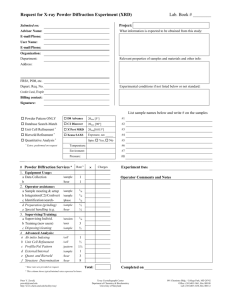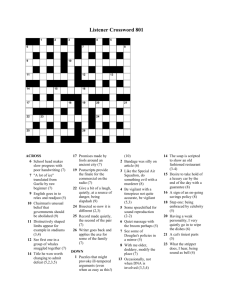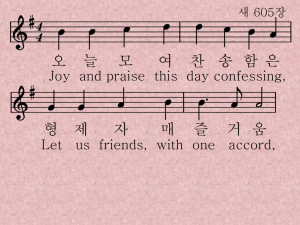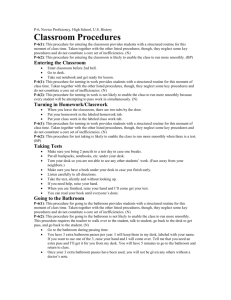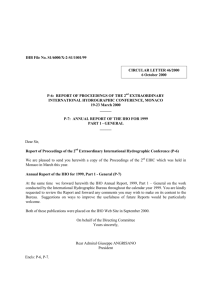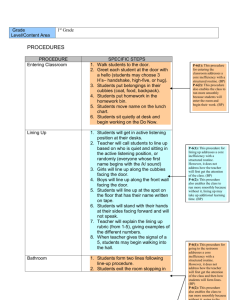Classroom Procedures - Teaching As Leadership
advertisement
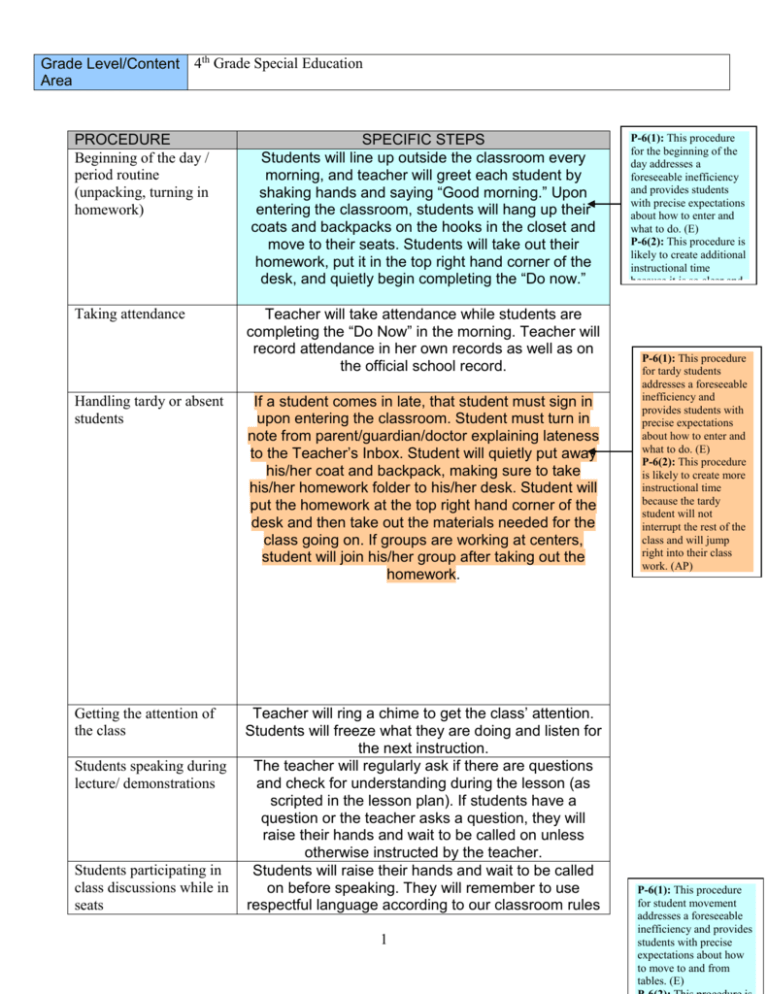
Grade Level/Content 4th Grade Special Education Area PROCEDURE Beginning of the day / period routine (unpacking, turning in homework) SPECIFIC STEPS Students will line up outside the classroom every morning, and teacher will greet each student by shaking hands and saying “Good morning.” Upon entering the classroom, students will hang up their coats and backpacks on the hooks in the closet and move to their seats. Students will take out their homework, put it in the top right hand corner of the desk, and quietly begin completing the “Do now.” Taking attendance Teacher will take attendance while students are completing the “Do Now” in the morning. Teacher will record attendance in her own records as well as on the official school record. Handling tardy or absent students If a student comes in late, that student must sign in upon entering the classroom. Student must turn in note from parent/guardian/doctor explaining lateness to the Teacher’s Inbox. Student will quietly put away his/her coat and backpack, making sure to take his/her homework folder to his/her desk. Student will put the homework at the top right hand corner of the desk and then take out the materials needed for the class going on. If groups are working at centers, student will join his/her group after taking out the homework. Getting the attention of the class Teacher will ring a chime to get the class’ attention. Students will freeze what they are doing and listen for the next instruction. The teacher will regularly ask if there are questions and check for understanding during the lesson (as scripted in the lesson plan). If students have a question or the teacher asks a question, they will raise their hands and wait to be called on unless otherwise instructed by the teacher. Students will raise their hands and wait to be called on before speaking. They will remember to use respectful language according to our classroom rules Students speaking during lecture/ demonstrations Students participating in class discussions while in seats 1 P-6(1): This procedure for the beginning of the day addresses a foreseeable inefficiency and provides students with precise expectations about how to enter and what to do. (E) P-6(2): This procedure is likely to create additional instructional time because it is so clear and specific. (AP) P-6(1): This procedure for tardy students addresses a foreseeable inefficiency and provides students with precise expectations about how to enter and what to do. (E) P-6(2): This procedure is likely to create more instructional time because the tardy student will not interrupt the rest of the class and will jump right into their class work. (AP) P-6(1): This procedure for student movement addresses a foreseeable inefficiency and provides students with precise expectations about how to move to and from tables. (E) Students moving to and from their desks to the rug or carpet Students participating in morning meeting or onthe-rug instruction Students interacting with a partner or small group and will use accountable language when sharing their opinions and thoughts. n/a Teacher will call on students by table group to move to the big table. Students will stand up, push in their chairs quietly, and take seats with their group at the big table. Once morning meeting is done, teacher will call on students by group to return to their desks. Students will use 6-inch voices so as not to disturb the other groups. At each table, one person will be the materials manager, one person will be the reporter, and one person will be the recorder. The reporter will also be in charge of making sure that everyone speaks in the group. Students will keep their jobs for a week, then switch, allowing each student the opportunity to have each job. Working with a small group while other students work independently Teacher will work with small groups at the little round table in the back of the room. During this time, other groups will move around to centers or remain with their table groups working on a set assignment. Teacher will set a timer, provide a one-minute warning, and ring the chime when it is time to move from one center to the next. Students speaking during independent work Students will work quietly by themselves unless otherwise instructed. If students have a question about the independent work, they are allowed to ask their neighbor in a 3-inch voice before raising their hand to ask the teacher. Taking tests/quizzes Students will move their desks so that they are 12 inches apart from their other small group members. The teacher will place tape markers on the floor to help students move their desks quickly and quietly. 2 P-6(1): This procedure for small group interactions addresses a foreseeable inefficiency and provides students with precise expectations about what to do. (E) P-6(2): This procedure is likely to create additional instructional time because it is so clear and specific. (AP) P-6(1): This procedure for working in small groups addresses a foreseeable inefficiency and provides students with precise expectations about how to enter and what to do. (E) P-6(2): This procedure is likely to create additional instructional time because it is so clear and specific and both the teacher and students can stay focused on work. (AP) P-6(1): This procedure for taking tests addresses a foreseeable inefficiency and provides students with precise expectations about how to do so. (E) P-6(2): This procedure is likely to create additional instructional time because it is so clear and specific, and the procedure can be acted on accurately and quickly thanks to tape markers. (AP) Students will complete their own test or quiz independently (unless otherwise instructed), which means silently and with their eyes on their own papers. If a student has a question, he/she will raise his/her hand. Giving instructions and being understood If students are moving around the room and/or working in small groups, teacher will ring the chime and the students will freeze before the teacher gives instructions. Teacher will provide both written instructions on the blackboard (using pictures and words) as well as verbal instructions. Teacher will check for understanding by randomly calling on students to repeat back directions before allowing the class to begin working. Distributing materials The four materials managers (one from each small group) will be in charge of distributing materials from their Materials Box (already at the table). Collecting materials The materials manager from each table will also be responsible for collecting materials together from his/her small group and returning them to the Materials Box, which remains at the table. Students will put all of their work from the previous class away in the appropriate folder, and will clear their desks of everything but the materials needed for that class. Teacher will time this process and the class will try to “beat the time,” with the teacher writing the new record up on the board. If the class has been sitting for a long time, the teacher may lead the group in a quick game of “Simon Says” or other game (students remain standing at their desks) before starting the next class. Transitioning between activities while seated Transitioning between activities while moving around the classroom P-6(1): This procedure for transitioning between activities addresses a foreseeable inefficiency and provides students with precise expectations about what to do with work and materials. (E) P-6(2): This procedure is likely to create additional instructional time because it is so clear and specific. It also provides urgency for students by giving them an incentive to “beat their time.” (AP) Teacher will ring the chime and everyone will freeze where they are. Teacher will give directions for cleaning up centers/finishing up activities and will then set the timer for one minute for students to finish 3 P-6(1): This procedure for going to the restroom addresses a foreseeable inefficiency and provides students what they are doing. Students will then either move clockwise to the next center or around the perimeter of the room until they reach their seats. Going to the restroom Sharpening pencils Getting water In accordance with school policy, no student will be allowed to go to the bathroom before 10am or after 2pm unless it is an emergency. Students may only go to the bathroom during independent practice, and in order to ask permission the student will silently raise a closed fist in the air. The teacher will nod assent if it is an appropriate time, and the student will sign out and pick up the bathroom pass before going to the bathroom. When they get back to the classroom, students will sign in again and hang up the pass by the door. Unless otherwise instructed, only one student at a time may get up and move around the classroom. Teacher will keep a basket of sharpened pencils on her desk. If student needs a new pencil, he/she will quietly raise the broken pencil in the air, wait for assent from the teacher, then quietly get up, put the broken pencil in the basket, and take a sharpened one. One of the classroom jobs will be the pencil sharpener, who will come in 10 minutes early to sharpen all of the pencils in the basket from the day before. Unless it is an emergency, students will only be allowed to get water after recess or specials. If it is part of an individualized positive reward or behavior management plan, a student can ask to go get a drink of water by raising an arm with a sign language “W” in the air. Teacher will nod assent if appropriate, and student will sign out, pick up the pass by the door, and exit silently. 4 P-6(1): This procedure for sharpening pencils addresses a foreseeable inefficiency and provides students with precise expectations about how to do so. (E) P-6(2): This procedure is likely to create additional instructional time because it is so clear and specific, and employs clear hand signals for students to silently communicate their needs. (AP) P-6(1): This procedure for getting water addresses a foreseeable inefficiency and provides students with precise expectations about how to do so. (E) P-6(2): This procedure is likely to create additional instructional time because it is so clear and specific, and employs clear hand signals for students to silently communicate their needs. (AP) Getting tissues Throwing trash in the garbage Students going to pull out programs Unless otherwise instructed, only one student at a time may get up and move around the classroom, and only during independent practice. Students do not need to ask permission to get a tissue, but the student must look to make sure no one else is walking around before quietly walking over to get a tissue. Unless otherwise instructed, only one student at a time may get up and move around the classroom, and only during independent practice. Student will raise one finger up into the air, and when teacher nods student will quietly get up and throw away his/her trash. When the service provider comes to pick up a student, that student will neatly and quietly put away his/her materials, push in his/her chair, and sign out at the door before going to his/her pull out program. Lining up to leave the classroom Teacher will call groups to line up based on which group is sitting in active listening position with all materials put away. When teacher calls one group to line up, those group members will stand up quietly and push in their chairs before going to the door and lining up. If they are talkative or do not all push in their chairs, they must all sit back down and try again. Movement through the hallways and on the stairs Students will walk in one straight line as a group. Students will walk silently, about half an arm’s length apart with hands to their sides. If the class needs to stop in a hallway or stairwell, the class will move to the right side of the wall/stairway and wait for teacher’s signal to keep walking. The teacher will take the back of the line at all times. Students will line up according to height order, standing about half an arm’s length apart. The line will only begin to move once students are in a straight line and quiet. Students will line up against the wall outside the classroom, and the teacher will remind them that they should enter the classroom quietly, move to their desks and take out their materials for the next class. Teacher will give each student a silent high-five as he/she enters the classroom. There will be a list of things students can do if they finish early. T.A.I. and reading your independent reading book will always be options; there will also be extension activities for each lesson (differentiated instruction). Lining up to return to the classroom (from outside or a different location) Re-entering the classroom after recess, lunch or another activity Students completing work early 5 P-6(1): This procedure for lining up addresses a foreseeable inefficiency and provides students with precise expectations about how to do so. (E) P-6(2): This procedure is likely to create additional instructional time because the steps are so clear and specific and so more time can be spent learning. (AP) P-6(1): This procedure for finishing early addresses a foreseeable inefficiency and provides students with specific expectations about what to do. (E) P-6(2): This procedure is likely to create additional instructional time because time for learning is being maximized. (AP) End of the day/period routine (packing-up) Attending an assembly At the end of the day, each group will pack up their materials, ensuring to put their homework folder and planner in their backpacks. The entire class will then recite the class motto “Work hard, get smart.” Teacher will call students by small group to line up. Each student will put his/her chair up on his/her desk and walk quietly to the door. Students will line up in height order. Teacher will lead them down to the designated pick-up area. The class will line up in height order quickly and quietly and will walk as a group down to the auditorium. The group will file in to the rows in the same order as the line and sit together as a class. During the performance, students will be attentive and quiet. Emergency fire drills Teacher will collect the class attendance sheet. If needed, students collect their jackets from their lockers before lining up. Students will line up in height order quietly and quickly. The first student in line will hold the door for the class, and the last person out of the classroom will turn off the lights. The class will walk out of the school following the designated route to the front of the school building. Teacher will check to make sure all students present in school that day are accounted for. Handling interruptions to class (visitors, phone, loudspeaker) If the loudspeaker goes off in class, everyone in the room will freeze what they are doing and listen to the announcement. If the phone rings or the teacher has to talk with someone who comes to the door, students will be allowed to talk to their neighbor in 3-inch voices (asking each other questions about the material) until the teacher comes back. Any visitors who come to observe the class (parents, PD, principal, DOE employees, etc.) will be directed to the visitor’s table and class will continue without interruption. Students will not interact with a person seated at the visitor’s table unless directed to do so by the teacher. 6 Narrative Plan to Introduce Procedures EVALUATOR: In noting your students’ strong performance thus far, I’m wondering about what factors contributed to this great start. Can you take me back to the first day of school and tell me how you taught procedures in your classroom? I’m curious to know how the procedures you have designed and introduced might have contributed to current student performance. TEACHER: Sure. I knew that I couldn’t teach all of my procedures on the first day – I mean, you’ve seen that list – so I decided to pick the ones that I thought would be most important from the very beginning and teach them from the start. I’ve always planned to have lots of centers in my room, and I knew it was going to be vital for my kids to be able to move through them correctly, because I’m going to be doing a lot of work with small groups, and I want the rest of the class to be pretty self-guided. EVALUATOR: OK. So take me through how you specifically taught that. TEACHER: Well, I started by doing a class brainstorm, where I asked them to think of all the different procedures they remembered having in their third grade classrooms. Then I said we were going to focus on centers today, because centers were going to be one of the most important (and fun!) parts of our room this year. I explained the steps for how to move around centers, and then I demonstrated myself, each step of the way, and sort of did a think-aloud as I went around the room. Then I did it again, but this time I did it wrong, and asked my students to tell me how I hadn’t followed the procedure correctly; each table had to write down four things I had done wrong, and then share one (following the other procedure we had learned that morning, with the recorder and the reporter). Finally, I wanted to see if my students could do the procedure for themselves, so I asked all my students to stand up and practice moving through centers. EVALUATOR: So what happened? TEACHER: Well, they did it, but we had to practice three times, which is fine with me. They got faster each time, and by the third practice, they were doing it perfectly. To wrap it up, they completed a little exit slip about the steps of that particular procedure before they left for lunch. P-6(3): Students also had an opportunity to demonstrate comprehension of the procedure through an exit slip. (AP) 7 P-6(3): Students had the opportunity to demonstrate their comprehension of a particular procedure by modeling the procedure after the teacher explained it and modeled it. (AP)

